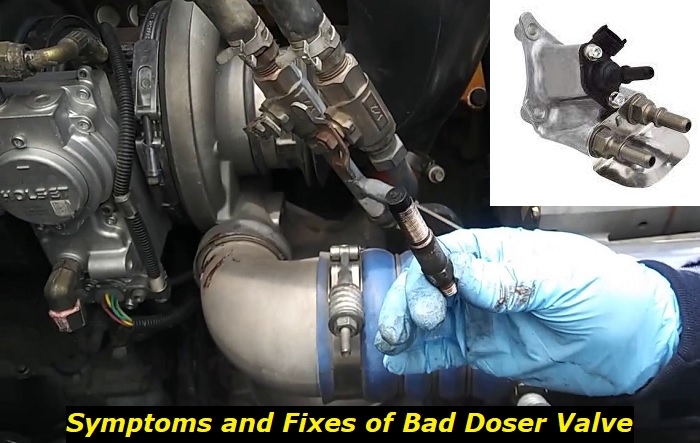Bad Doser Valve Symptoms and Ways to Fix the Problem
Big engines for industrial use and those used to power heavy-duty semi-trailers are seen to produce a lot of harmful gases to the environment. Even after making the most efficient engine equipped with DPF and EGR, the exhaust gases from these engines are still seen to be excessive. It is, for this reason, a doser valve is used to inject DEF into a mixer chamber from where the exhaust gases mix with DEF before entering the SCR.
In our article, we take a tour around the truck to understand the symptoms of a bad doser valve. We also take a look at how one can fix these problems. But to best understand ways to fix these problems, we will explore what is a doser valve and how it works.

Understanding doser valve
A doser valve is a small gadget installed in heavy-duty diesel engines like Cummins ISX15 to help reduce the NOx presence in the exhaust gases of a semi-trailer. In 2010, after EPA introduced regulations on emissions, Tier 4 final diesel engine manufacturers found the need to make the diesel exhaust fluid (DEF) part and parcel of the engine.
DEF is a chemical mixture comprising 32.5% high-purity urea and 67.5% deionized water. The DEF transforms the harmful nitrous oxide in exhaust gas into nitrogen and water. The DEF is injected into the Selective Catalytic Reduction (SCR) chamber, where the reaction of converting harmful NOx into water and breathable nitrogen.
The doser valve, or as many people and experts in the trade call it, the DEF injector, is the gadget responsible for the injection of the DEF into the SCR or a mixer chamber. During the actual injection of the DEF, the valve releases a fine mist inside the SCR. Inside the SCR, DEF reacts with the exhaust fumes, a process enhanced by the SCR catalyst.
A doser valve is a metal component that is usually made using aluminum. It is attached in place using three 10mm bolts. Usually, a DEF line and two other cooler lines run into it. The doser has three-minute holes that dispense the fluid as a mist into the SCR. It is the functioning of these three small holes that usually become compromised and which cause all the doser valve problems you can think of.
Common doser valve problems
1) Corrosion
Some owners of semi-trailers have found that corrosion is the leading cause of the doser valve issues. Upon removing the valve, one finds corrosion on the gasket and the attached surface, which then interferes with the three small holes that eject a mist of DEF.
2) Crystallization
Crystallization is a common problem caused by topping up with hard water or over-dosing. Adding too much DEF in the system causes it not to hydrolyze fully, causing scale and deposits to form along the DEF line and in the doser valve. This causes it to block and be unable to eject DEF. Once DEF has crystallized inside the valve, the three holes are closed or choked, making DEF leak from the tip.
3) Contamination
DEF can have impurities such as metal particles and dirt. Such contamination causes scale buildup and clogging of DEF lines, and this compromises the valve's effectiveness. At times such contaminants block the valve jets making the valve ineffective.
Symptoms of bad doser valve
1) Vehicles consuming too much DEF fluid
The most obvious symptom of a faulty DEF system is DEF is running out uncharacteristically fast. When you notice your vehicle is consuming a lot of DEF, check the DEF system for a malfunction. The doser valve may be leaking, which causes the DEF reservoir to run low fast.
2) The white substance on the exhaust and the pipes
This is a symptom that you should consider alongside others. When you see the exhaust emitting some white substance, then you likely have a problem with the dosing valve and should consider replacing it.
3) Check engine light (CEL)
The check engine light will appear on the dash when damage has already started to happen in the system. The crystallization or scale might compromise the SCR sensor and damage it. The check engine light will appear when various sensors, such as temperature ones, are affected and have malfunctioned.
4) A blocked filter
When the DEF doser nozzle is not able to spray a fine mist, over time, the filter becomes very hot and eventually gets clogged. By the time the filter is clogged, the check engine light should pop up and warn you of the danger your DEF system is in.
5) Decomposition pipe blocked
One of the easiest tricks used by some mechanics and owners of trucks is to check whether the decomposition pipe has any crystallized DEF to determine if the doser valve is ok. In almost all cases where there is scale and crystallized DEF inside the pipe, the doser valve is leaking and needs to be replaced.
The decomposition pipe test is done using a snake camera which doesn't require dismantling the valve or any other part. However, a buildup of DEF in the decomposition pipe might be in the later stages of a DEF problem, meaning that you are likely to replace other parts, such as sensors. By the time the decomposition pipe has this buildup of DEF, the check engine will have shown on the dash, and you will need to read the errors the ECU throws.
How to fix the doser valve
The doser valve is easily accessible on most trucks. It is located along the exhaust system, where it injects DEF fluid into a mixing chamber found between the diesel particulate filter (DPF) and the SCR. Three lines go into the valve; the DEF and two cooling lines.
- Start by clamping off the lines to prevent DEF from pouring once you disconnect the lines from the doser valve.
- The valve is fixed in place with three 10mm bolts which are easily accessible. In some cases where the valve has stayed for years, the bolt might break, which then means you may need the help of an expert.
- Every truck has a specific doser designed for it; you should therefore search for the correct piece to avoid inconvenience or returning and replacing the part.
- Once the doser valve is removed, you should check for any blockage. Clean out any crystallization or scale from the path of the DEF. Failure to remove this blockage will lead to the check engine light popping on the dash, and a whole lot of problems will accompany it.
- It is recommended that every time a doser valve gets replaced, the gasket be replaced too. Some valves come with gaskets, and others are two-piece.
Tips on how to use the doser valve
The doser valve is a part that should be replaced once in a while. The best way to deal with the doser valve problem is to replace it yearly. This applies to the three-pin nozzle heads, but you can do it every two years for the shower head nozzles.
When you look at how the doser valve works and the chances of it getting damaged, as an experienced heavy-duty semi-trailer owner or operator, you will appreciate the need to replace it before it spoils. Whenever you see the CEL, chances are there is something else in the system that is already damaged. You might replace the filter and some sensors on top of replacing the valve.
The doser valve has always been a pricey gadget which was going for over $400 until the newer version of them came in and the price dropped to $250. However, when you take your truck to the dealership, replacing the doser valve will likely cost $400 or more. Sometimes, the cost will reach $1,000 or more depending on the components they find faulty.
On eBay, you can find aftermarket doser valves, some of which are from renowned manufacturers at a price ranging between $40 and $70. This means you can replace the doser valve at a fraction of the dealership's price. You could even have a spare valve to change while on the road.
Replacing the doser valve regularly and maintaining them clean reduces the number of trips you take to the mechanic. You also reduce the chance of getting the valve clogged up, which can burn up the pump and cause a whole lot of problems.
If your truck has been sitting around for some months, the doser valve tends to become crusty on the nozzle, which then makes the valve ineffective. A few months after, you will start experiencing problems with the DEF system. Changing the valve whenever you buy a used truck is also advisable because it has been sitting around for quite some time.
Conclusion
The doser valve is a unique part many newbie drivers and owners need to learn more about. When you take your vehicle to the dealership to replace this part, the total bill might be too high, and in some cases, some serious damage will already have happened. The trick to dealing with the doser valve is to follow the above tips and look out for the given symptoms to avoid encountering these problems.

Add comment